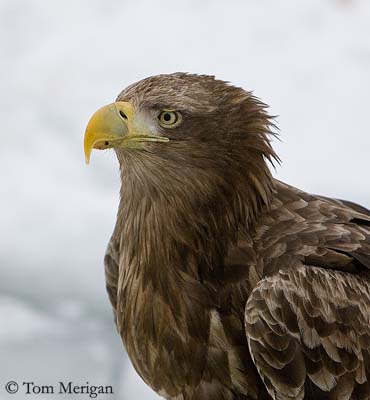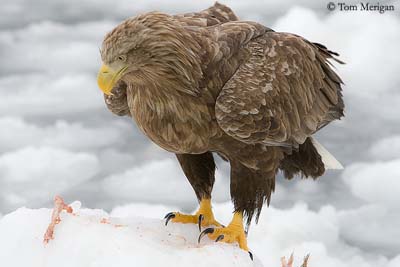
White-tailed Sea-Eagle
Haliaeetus albicilla
Accipitriforme Order – Accipitridae Family
BIOMETRICS:
Length : 69-92 cm
Wingspan : 200-245 cm
Weight : M : 4,100kg – F : 5,500 kg
LONGEVITY:
About 27 years in wild.
Up to 42 years in captivity.
DESCRIPTION:
Also called Sea-Eagle, the White-tailed Sea-Eagle is the largest of the European raptors. This eagle lives in the northern parts of Europe and Asia.

Adult has brownish plumage, with upper back and wing coverts brown with buffy-white edges and washes. Rest of body is brown, with darker flight feathers, lower back and underparts. The wedge-shaped tail is short and white.
Head, neck and upper breast are paler, rather pale buff, becoming whitish in old birds.
The strong, hooked bill and legs are yellow. Feet are armed with black talons. Eyes are yellow with narrow yellow eye-ring.

Both sexes are similar, with female slightly larger than male.
Juvenile has blackish-brown plumage. Head, bill, eyes and tail are dark. It shows whitish spots on axillaries.
It needs 5-6 years for reaching the adult plumage. Tail becomes white only at 8 years, and bill is yellow at about 4-5 years.
It reaches its sexual maturity at 5 years.

VOICE:
White-tailed Sea-Eagle is vocal mainly during the breeding season, during courtship displays and defence of territory.
It gives powerful calls. Male utters more raucous sounds than female which gives lower calls.
Contact call is a long series of “krick rick rick rick rick” increasing in frequency and pitch.
Alarm call “kli kli kli” is also used in defence of territory against other sea-eagles.
HABITAT:
White-tailed Sea-Eagle needs aquatic habitats where it finds its preferred food, the fishes.
It frequents fresh and marine waters such as coasts, rocky islands, rivers, marshes and lakes.
It needs sea cliffs or woods with tall trees for nesting.
RANGE:
White-tailed Sea-Eagle lives from northern tundra to steppes of temperate areas.
It breeds in northern Europe (Iceland, Finland and Scandinavia), and northern Asia (Siberia).
Only the northernmost populations migrate southwards in winter.

BEHAVIOUR:
White-tailed Sea-Eagle feeds mainly on fish, taken dead or dying. It catches the living fish usually without plunge, and primarily takes the preys swimming near the surface. It hunts in quiet waters, where the detection is easier. It also searches for prey by circling at 200-300 metres height, or by flying low above the water.

It catches the prey with the talons hold forwards while it performs wing beats just above. It also performs dives, but rarely.
When the prey is too big, it performs wing beats while it drags along the heavy fish still in the water.
This eagle may stay motionless in shallow water and catch fish swimming by.
White-tailed Sea-Eagle also consumes small mammals (rodents, rabbits), ungulates (goats, deers) often taken as carrion. It takes birds such as seabirds or water birds, attacking them on the water, and harassing them until exhaustion. It also takes eggs and chicks at colonies.
It steals food from other birds, and may eat offal from fishing boats.

White-tailed Sea-Eagle returns every year, or is resident in its territory. When spring is coming, pairs fly above their territory, performing courtship displays. Both mates fly together, close to each other at about 200 metres height, and make some displays including dives and games as attacks.

FLIGHT:
White-tailed Sea-Eagle performs slow, stiff wing beats. It is very agile when hunting. Often seen soaring thanks to the large wings.

REPRODUCTION:
Breeding season and laying vary according to the latitude.
White-tailed Sea-Eagle builds the nest mainly on rocky ledges in sea cliffs, or in high trees in fork or near the trunk. The nest-site is usually near the feeding area, between 3 and 6-11 km. Each pair has two or three nests used alternatively.
The airy is very bulky, made with sticks and branches. The interior is lined with twigs, moss, grass, seaweeds, lichens, ferns or wool.

Female lays two eggs, every 2-4 days. Incubation lasts 34 to 46 days, 38 days on average per egg. Both male and female incubate, but female more than male. At hatching, chicks are covered with grey down, becoming grey-brown later.
During the first two weeks, one adult remains at nest and then both parents hunt together.
Young fledge at 70-80 days of age, and remain in the surroundings 2-3 weeks more. They become independent one or two months later.

DIET:
White-tailed Sea-Eagle feeds mainly on fish, but it also takes small rodents and small mammals such as rabbits and hares, and larger mammals as carrion. It takes eggs and chicks from aquatic bird’s colonies, and catches seabirds or water birds by harassment in water.

PROTECTION / THREATS / STATUS:
White-tailed Sea-Eagle is classified as VULNERABLE.
It suffered heavy declines in 19th century with extinction of several populations. But the recolonizations during the 20th century allowed increases in most parts of Europe, except in SE Europe.
This species is threatened by persecution, poisoning (baits) and habitat loss with drainage of wetlands and deforestation.
White-tailed Sea-Eagle is protected, but several threats continue to varying degrees with pollution and degradation of habitat.
Fr: Pygargue à queue blanche
All: Seeadler
Esp: Pigargo Europeo
Ital: Aquila di mare codabianca
Nd: Zeearend
Russe: Орлан-долгохвост
Sd: Havsörn
Photographs by Tom Merigan
His website: Tom Meriganís Photo Galleries
Text by Nicole Bouglouan
Sources:
HANDBOOK OF THE BIRDS OF THE WORLD Vol 2 by Josep del Hoyo-Andrew Elliot-Jordi Sargatal - Lynx Edicions - ISBN: 8487334156
GUIDE DES RAPACES DIURNES – Europe, Afrique du Nord et Moyen-Orient de Benny Génsbol – Delachaux et Niestlé – ISBN : 2603013270
LES AIGLES par Maurice Dupérat - Artémis Editions - ISBN: 2844164536